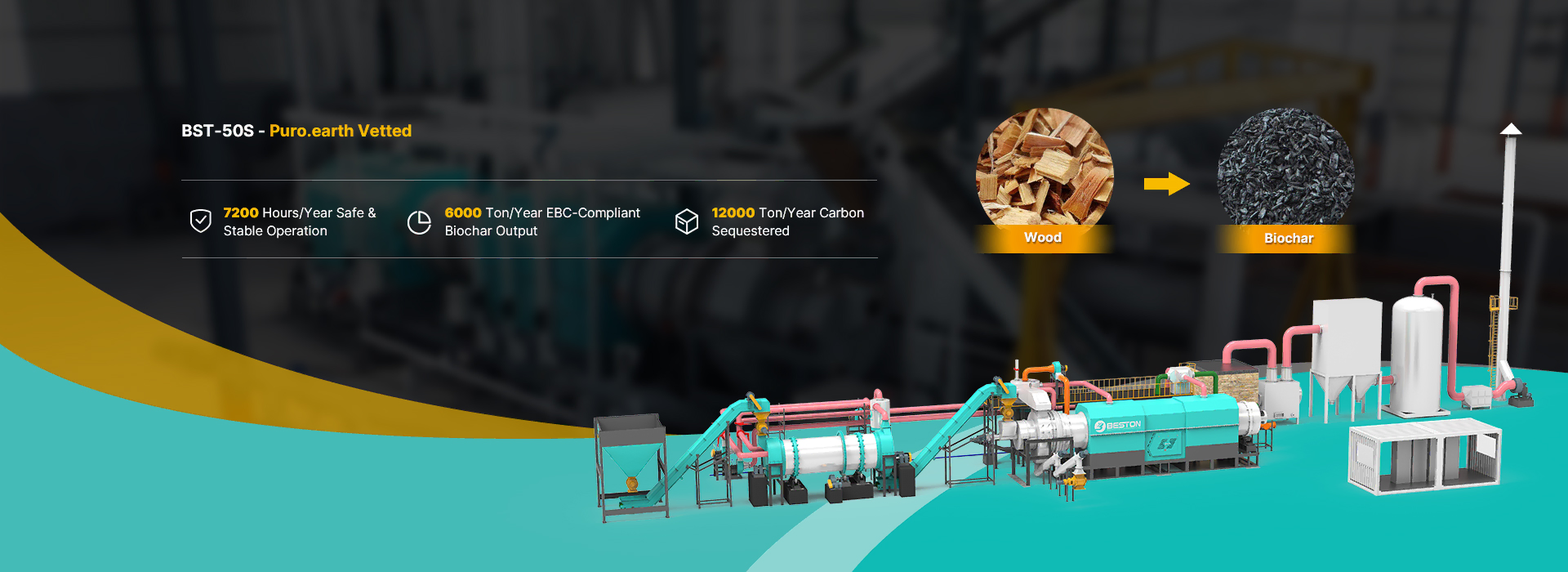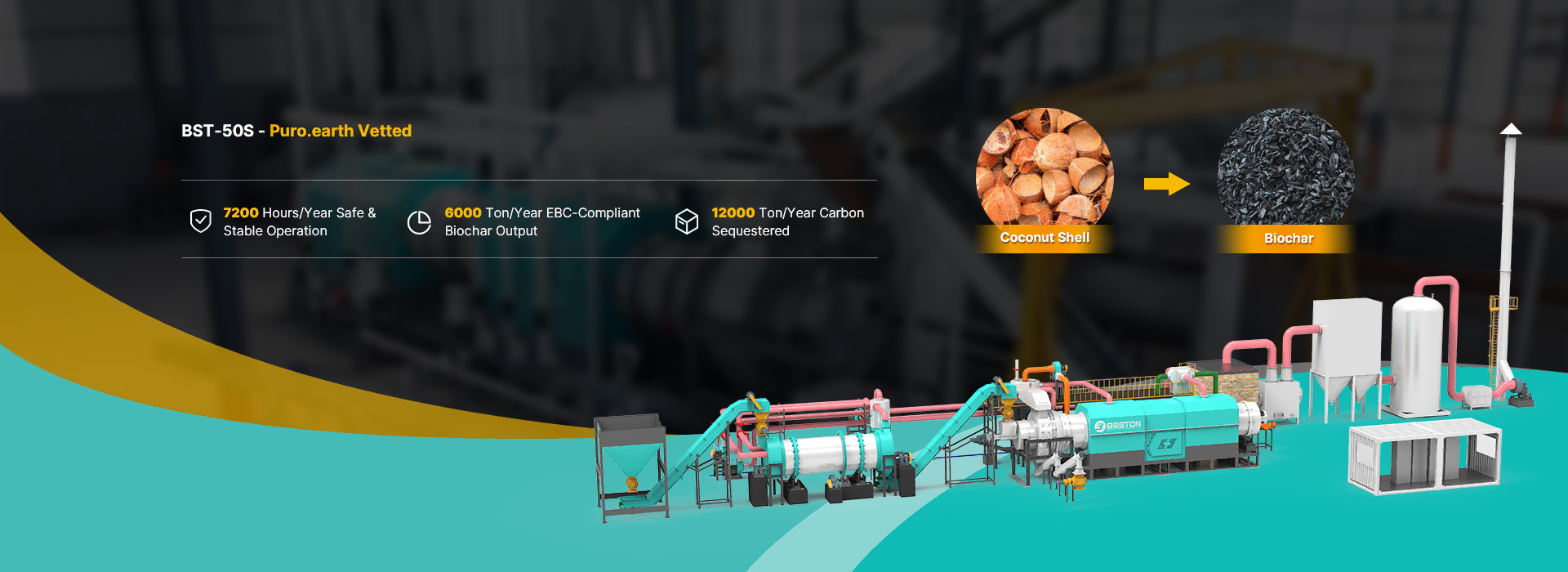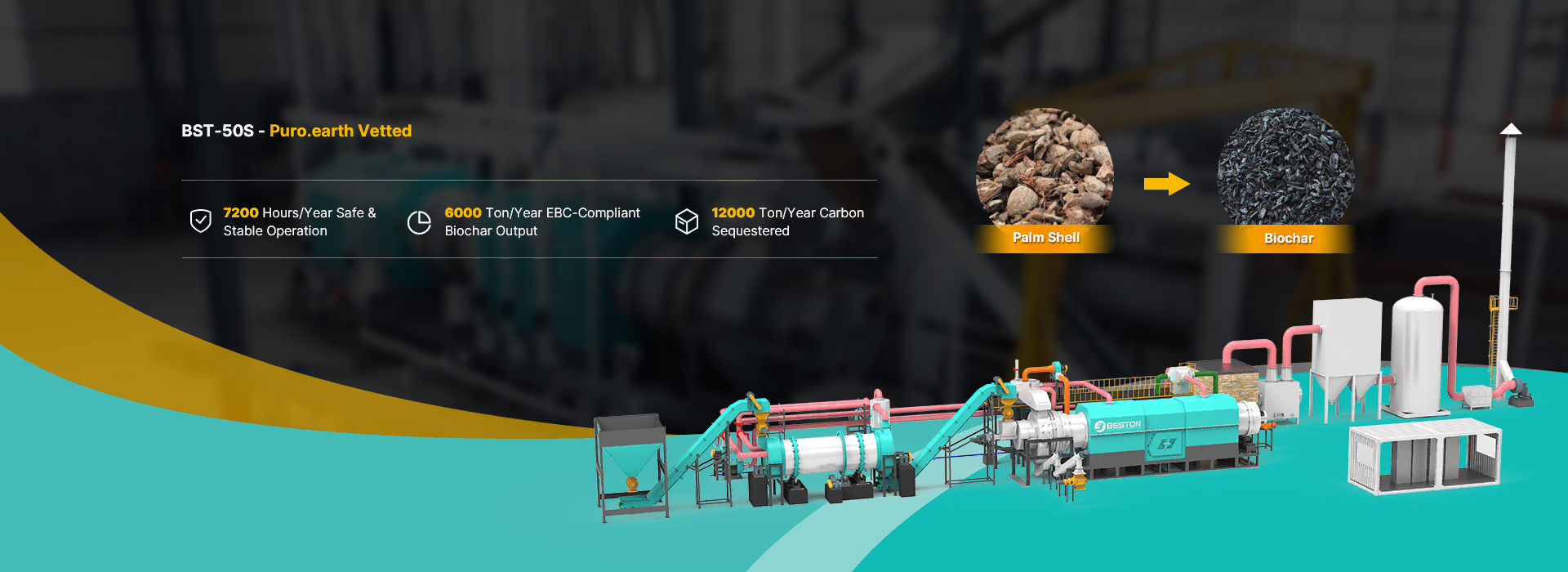
Charcoal making machine converts biomass waste into charcoal in a high-temperature, oxygen-free environment. This technology promotes resource recycling and drives the development of the circular economy. In today’s context of increasing emphasis on sustainable development, it offers significant potential and prospects for reducing environmental burden and achieving green production.
Charcoal Making Machine: Carbonization + Charcoal Briquetting Solution

1. Carbonization System
- Role: The core component of the entire charcoal production line.
- Principle: Utilizes a continuous high-temperature pyrolysis process under 400–600°C in a sealed reactor, where volatile substances in biomass are decomposed to produce high-quality charcoal powder.
- Output: Charcoal powder
2. Charcoal Briquetting System
- Role: A key auxiliary module located at the post-carbonization stage.
- Principle: Compresses the charcoal powder through high-pressure molding into dense charcoal products of various shapes, making them easier to store, transport, and commercialize.
- Output: Various charcoal blocks (e.g., charcoal briquettes, charcoal rods, charcoal balls)
Parameters of Charcoal Making Machine for Sale

BST-50S Model
- BST-50S technology vetted by Puro.earth
- 6,000 tons biochar production annually
- 7200H/Y stable & safe operation

BST-06 Model
- 8000H/Y stable & safe operation
- Low-cost carbon removal process verification
- Small-scale test machine
| Model | BST-50 Standard | BST-50S LM | BST-50S HM | BST-50S MAX | BST-06 Standard | BST-06MAX |
|---|---|---|---|---|---|---|
| Time to Market | 2015 | 2022 | 2022 | 2022 | 2025 | 2025 |
| Operating Mode | Continuous | Continuous | Continuous | Continuous | Continuous | Continuous |
| Application | Commercial Scale | Commercial Scale | Commercial Scale | Commercial Scale | Testing | Testing |
| Dust Removal System | Standard | Advanced | Advanced | Advanced | Standard | Advanced |
| Feeding Capacity | 10-15m³/h | 10-15m³/h | 10-15m³/h | 10-15m³/h | 100-300KG/H | 100-300KG/H |
| Biochar Discharge Temperature | 45℃ | 45℃ | 45℃ | 45℃ | 45℃ | 45℃ |
| Puro.earth Authentication Model | × | √ | √ | √ | × | |
| Maximum Pyrolysis temperature | 650℃ | 650℃ | 650℃ | 850℃ | 650℃ | |
| Service Life | 5-8 years | 5-8 years | 5-8 years | 8-10 years | 5-8 years | |
| Annual Operating Time | 7200 hours | 7200 hours | 7200 hours | 7200 hours | 8000 hours | |
| Land Space Required (L*W*H*m) | 35m×15m×8m | 65m×15m×8m | 65m×15m×8m | 65m×15m×8m | 25m*18m*6m | |
| Total Power (KW) | 201.25kW | 453.35kW | 505.35kW | 505.35kW | 129.79 | 162.79 |
| Cooling Method | Recycling cooling Water | Industrial chiller | Industrial chiller | Industrial chiller | Recycling cooling Water | Industrial chiller |
| Installation Period (Calendar Days) | 50 | 70 | 70 | 70 | 45 | 50 |

Option 1: Charcoal Ball Press Machine
- Compress materials into balls (40mm-60mm as normal size).
- Accept customized sizes by changing the molds.

Option 2: Charcoal Stick Briquette Machine
- Operate at a stamping rate of 40 times per minute.
- Produce 3 rods per stamping.
- Able to produce various charcoal rods, including square, hexagonal, and cylindrical shapes with lengths not exceeding 8cm.

BST-50S Charcoal Machine: Tech Advantages of Puro.earth-vetted Model

Tar & Wood Vinegar Self-Cleaning System
The system in charcoal manufacturing machine prevents blockages caused by tar, wood vinegar, and other substances. Benefits:
- Reduce downtime and maintenance and related economic loss.
- Better meet environmental compliance.
- Enhance safety by lowering the risk of fire and dust explosions.
Multi-stage Carbonization Structure Reactor
The reactor has a dual-cylinder + rotary design. Biomass undergoes uniform heating, is sequentially dried, semi-carbonized, and full carbonized within different temperature zones. Benefits:
- Ensure high-quality biochar production.
- Increase thermal efficiency of charcoal maker machine.
- Save floor space of the reactor.
Low-Nitrogen Combustion & Emission Control Design
By optimizing the combustion structure and precisely controlling the air supply, the BST-50S charcoal making machine minimizes pollutant formation.
- Meet EU emission standards and deliver outstanding environmental performance.
- Reduces fuel consumption and overall operating energy use.
- helps enterprises achieve sustainable development and carbon reduction goals.
High-temp Pyrolysis Technology
The maximizes the conversion of biomass organics into stable fixed carbon. The biochar meets key EBC (European Biochar Certificate) standards, including limits for hydrogen-to-carbon molar ratio, heavy metal content, and PAHs.
- Ensure stable production of high-quality, EBC-grade biochar for long-term carbon sequestration;
- Facilitate carbon dioxide removal (CDR) and carbon credit trading, creating measurable and verifiable carbon asset value.
Available Biomass for Charcoal Production Machine

Wood-Based Biomass
- Tree branches, bark, and twigs
- Sawdust and wood chips
- Timber offcuts

Hard-Shell Biomass
- Coconut shells
- Walnut, cashew, or hazelnut shells
- Olive pits and peach stones

Agricultural Residues
- Rice husks and straw
- Corn cobs and stalks
- Sugarcane leaves

Oil Palm Waste
- Palm kernel shells (PKS)
- Empty fruit bunches (EFB)
- Palm fiber
Showcase Collection of Biomass Charcoal Making Equipment
Charcoal & Charcoal Briquettes Applications

Charcoal Powder (Biochar)
Key Features: High surface area, Strong adsorption capacity, Stable structure and resistant to decomposition
Key Applications: Focus on Environmental & Agricultural
- Soil amendment / Soil improvement
- Carbon sequestration
- Construction material (e.g., additive in cement, concrete)
- Animal feed additive
- Reducing agent in metal smelting

Charcoal Briquettes
Key Features: Uniform shape and density, Stable and clean combustion, High energy density
Key Applications: Focus on Energy & Fuel
- BBQ fuel
- Industrial fuel for heating and power generation
Charcoal Production Projects Around the World
How Does A Beston Charcoal Making Machine Work?
01 Pretreatment
Before carbonization, the biomass must meet specific feeding requirements:
- Moisture content: ≤ 15%
- Particle size: ≤ 20 mm (ideally 5–8 mm)
If the biomass exceeds these limits, a dryer or crusher is required to adjust the moisture and particle size.
02 Feeding
03 Carbonization
Using traditional fuels (such as coal, wood, and natural gas) to heat the reactor for 60-90 minutes.
- At around 150°C, the biomass begins to decompose into gases such as CO₂ and CO.
- At around 350°C, continuous formation of charcoal powder begins. The carbonization process typically lasts 15–25 minutes.
- After about 30 minutes, a large amount of syngas is produced, which can be recycled for heating the biochar reactor.
04 Syngas Recycling
The generated syngas is purified and reused to heat the reactor. This self-sustaining recycling system reduces external fuel consumption and significantly improves energy efficiency.
05 Cooling & Discharging
06 Dedusting
The dedusting system (cyclone dust remover, spray dust collector, etc.) removes harmful components such as sulfur from the flue gas. After treatment, the emission meets EU environmental standards.
07 Charcoal Briquetting
International Standard Assurance | ISO & CE Certified



Beston Group Strength: A Reliable Charcoal Making Machine Supplier

EPC ADVANTAGE
- Integrated “Construction + Digitalization + New Energy” Solution: In collaboration with industry leaders such as Huawei and LONGi Green Energy, we deliver smart and zero-carbon solutions that significantly reduce operational energy costs.
- Full-Chain Capability of “Creative Design + Engineering Construction + Equipment Manufacturing”: By applying BIM technology, we achieve precise coordination across design, construction, and equipment, shortening project delivery cycles and enhancing quality performance.
SERVICE FIELD
- Industrial park planning and design
- Steel structure workshop construction
- Equipment installation and commissioning
- Park roads, water supply and drainage works
- Supporting facilities such as office buildings and dormitories
Modern Charcoal Machine vs Earthen Kiln: Enjoying Greater Policy Advantages

Easier Environmental Compliance & Regulatory Approval
Earthen kilns are mostly open or semi-enclosed, leading to incomplete combustion and heavy smoke emissions. As a result, they are facing increasing government restrictions.
Modern charcoal making machines meet clean production standards and green industry policies. Its efficient and sustainable operating mode increases the chances of obtaining environmental approvals, emission permits, and market access.
Greater Access to Government Funding Support
Earthen kilns are inefficient, energy-intensive, and highly polluting. Such projects struggle to secure government subsidies and may face phase-out policies, rectification measures, or carbon emission penalties.
Modern charcoal making equipment follows the principles of circular economy, energy conservation, and carbon reduction. Such projects are more likely to receive financial support, such as grants, tax incentives, and green loans. This helps reduce investment costs, improve cash flow, and ensure long-term returns.


Better for Occupational and Community Health
Traditional charcoal kilns generate dense smoke during carbonization. Workers exposed over long periods are prone to respiratory and other health problems, while the emitted fumes and odors also degrade the living quality of nearby residents.
Modern charcoal production machines operate in enclosed conditions with flue-gas purification, significantly improving occupational safety and community air quality, and fostering a cleaner, more responsible industrial ecosystem.
Get Eco-Friendly Charcoal Production Solution Now
Seize the opportunity in charcoal making machine projects! It will drive economic growth and make a positive impact on the future of our planet. Contact Beston Group for customized solutions today. Follow us on LinkedIn to stay updated on the latest developments in our technologies and products.







